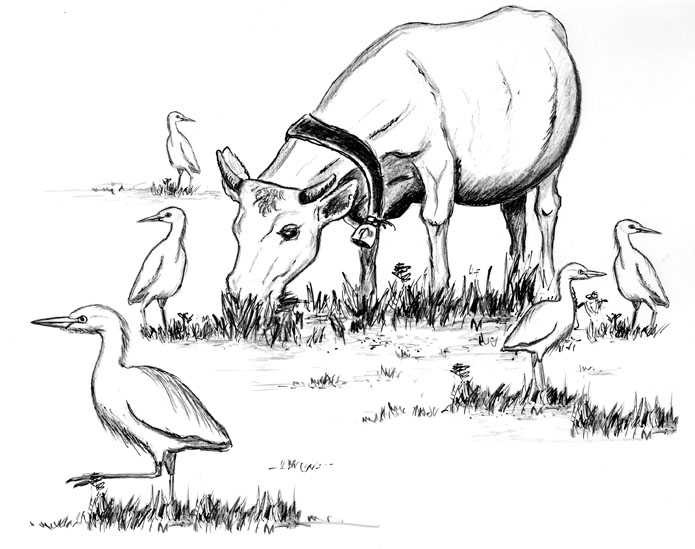
Dear Bird Folks,
I’ve always been under the impression that herons and egrets are basically fish eaters. But on a recent trip to North Carolina I saw fields filled with egrets and there wasn’t any water or fish within miles. What could they have been eating? Have egrets become vegetarians?
– Meredith, Fairfield, CT
That’s it, Meredith,
You got it exactly right. Egrets are becoming vegetarians. The thought of spearing little fish day after day has become unsettling to egrets. As a result they have abandoned their barbaric ways, have climbed out of the dingy swamps and moved into open fields where they feed on wild, free ranging tofu. By doing so the birds not only feel good about themselves, but their breath smells way better than it did when they ate fish all day, which really helps them in the dating world.
The birds you saw in the field are egrets all right, but they aren’t the typical American egrets. They are Cattle Egrets. Cattle Egrets are one of the most amazing birds you are ever likely to see, especially in North Carolina. Seventy years ago no one had ever seen Cattle Egrets in North America; now their population may exceed all other herons and egrets combined. Originating in Africa, Cattle Egrets have been steadily expanding their range. First they moved into South America and then North America and then as far away as Australia. They are like the old British Empire, determined to conquer the world. But unlike the Brits, these birds are actually welcomed when they arrive and they want nothing to do with tea.
In the late 1800s a handful of thrill seeking egrets somehow flew from Africa, across 4,000 miles of the Atlantic Ocean, to South America. Why they made such a blind faith journey is anyone’s guess. It could be that the birds couldn’t take the pounding of those African drums anymore or perhaps they simply had some extra air miles they needed to use up. Whatever the reason, they apparently liked what they found because they not only stayed, but they thrived and slowly spread throughout much of the continent. When they finished exploring South America, these egrets once again became restless and in 1943, set their sights on North America.
Usually when a foreign species invades a new ecosystem they become an annoyance (i.e., Japanese beetles, Norway rats, Australia’s Mel Gibson), but this is not necessarily the case with Cattle Egrets. For the most part, they play nice and have gotten along with the locals. Part of the reason why they have caused so few problems is their diet. They aren’t big fish eaters and thus don’t compete with the fish-loving native herons and egrets. As their name implies, Cattle Egrets are fond of cattle. However, they don’t eat cattle. If they did, they’d be competing with us (well, some of us). Cattle Egrets eat bugs. They are called “Cattle” Egrets because they are attracted to the insects that the big animals stir up as they move about the fields. And if there are no cattle to be found, the birds will look for something else to stir things up. They are just as happy to follow a plow, tractor or even homeowners mowing their lawns. They are also big fans of brush fires. The birds feast on insects scurrying to escape the flames. Smoke from a fire will attract egrets from all over. It seems these birds don’t often get a hot meal and they don’t want to miss out.
Cattle Egrets have no doubt benefited from our clear-cutting ways and our lust for more grazing and farmland. They have also been blessed with good timing because they did not arrive on this continent until the 1940s. Being late to the party meant they missed the golden age of the millinery trade and the senseless slaughtering that nearly obliterated all of our other egrets. Also, because fish aren’t at the top of their diet, DDT didn’t have the same impact on them as it did on the other fish-eating birds.
Cattle Egrets are not vegetarians, Meredith. They eat plenty of meat, but it’s mostly in the form of insects…the other white meat. Cattle Egrets aren’t perfect. They can be a problem at airports and they’ll occasionally start a smelly nesting colony too close to human habitation. But, on the whole, they blend in, mind their own business and cause few annoyances, rare for a foreign species. It’s too bad we can’t say the same thing about Mel Gibson.
On a different topic: Lots of folks are asking when they should take down their hummingbird feeders. Take them down when you want to, just keep them clean. By the first week of October most of the hummingbirds have migrated through New England. However, it doesn’t hurt to leave your feeders out a bit longer to help any stragglers. The idea that our feeders somehow keep the birds from migrating is silly. Food availability is not the reason why hummers migrate. (Remember, there are still tons of flowers available in the fall.) A deadly deep freeze is coming and they know it. Feeders don’t hinder migration, but they may keep a screwed up bird alive for a while, or at least until it can get its picture in the paper. Leave your feeders out as long as you want and stop feeling guilty about it.